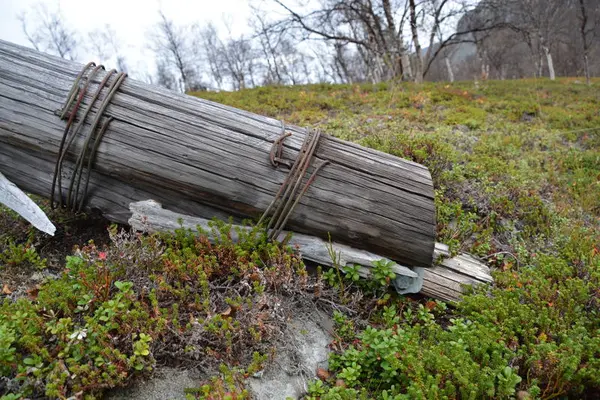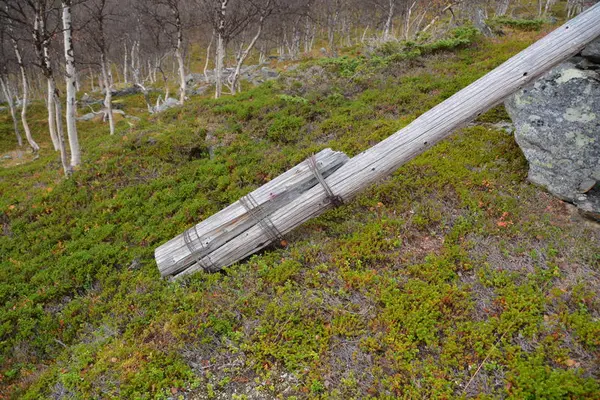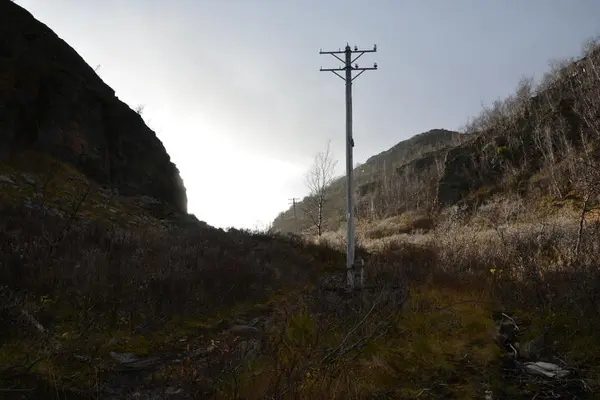-
Closeup of lashed splice Stein Domaas/Telemuseet
-It all happened in respectful silence, for no particular reason. That’s just how it was. I can’t really put it into words, tells Evald Lindgård. He was just 17 years old when he took part in raising the poles of Finnmark. He tells his story in the film, “Et liv i Televerket” (A Life In Televerket).
-They were probably in need of people in this department, because father called home and said he had got me into work. The young lad got on one of the boats going from Tromsø to Hammerfest in 1945. It was fully loaded with poles, line wire and other equipment. Evald could never forget the sight that met him further up north:
-All of West-Finnmark was ravaged. There was nothing left, absolutely nothing. It didn’t look real. It was hard to find anything to rest your eyes on, in a way. It was like a desert compared to what I was used to.
No part of Norway was hit harder by the war than Finnmark. Homes had been burnt, fishing boats made useless, bridges and power plants demolished, and to hinder communication, tele lines were cut and poles had been broken straight off.
Rumours had it that the Germans had used explosives to break the poles, but Evald is of the firm opinion that they had been shot to pieces.
-As we proceeded through the terrain, we could tell whether it was a short or a tall German who had done the job. If it was a tall man the stump would be tall and if it was a short man it would be shorter. There ended up being a lot of comments like; “he would’ve been 170cm, and he was 180,” he chuckles.
-
Pole from Mattisdalen with lashed splice Stein Domaas/Telemuseet
The Method
To reinstate the telecom network as quickly as possible, the various telegraph workers had to make use of the meagre materials they had available, that’s why the root of the broken pole became the anchor point for the new top.
-The old stump made all the difference, tells Evald.
-Without it, we would never have been able to get the lines to their destinations. We would lash the new pole to the stump using the old steel wire that was left on the ground, and inserted wedges around them. The wedges were made of wood or stone, he explains.
The method is described as “surreskjøting” (Lashed splice) in Tekniske Meddelelser (technical magazine) in 1948: The stump gave an overlap of 70-80 cm, and top and stump was lashed together. 5.3or 4.0 mm steel wires that was found lying on the ground was used for the lashing. Wooden wedges were inserted between the lashing and the pole. Occasionally, in the mountains, stone wedges were used.”
-
Remaining poles of line courses in Mattisdalen Stein Domaas/Telemuseet
Team work
Due to the bad roads in Finnmark and the lack of transport, the work was done using raw muscle power. Despite the rudimentary equipment, more than 10.000 functioning poles were erected during a few months. How was it possible? In the film about Evald Lindgård, he puts emphasis on the good team work.
-No one shied away from trusting another man as we were carrying the poles. There was an inherent discipline in all of us; a heritage transferred from man to man, and from department to department, a heritage going back long, long before my time, he says.
On the 10 December 1945, Evalds department had finished their work, and 70 years later the poles in Mattisdalen received a protection order. There they are today, standing as a symbol of humanity’s ability to rise again.
-Experiencing what humans can achieve, has given me a lot, says Evald Lindgård.
-Seeing what a nation can achieve.
At the end of 1945, all in all 113 stations were back in service, and most places in Finnmark were connected to each other, and the national grid, yet again. Many spliced poles are still standing as reminders of the reconstruction effort Evald Lindgård was a part of. The stretch Telenor has chosen to protect goes from Glupen/Glupesskaret to the lake, Slubboskaiddejavr, and consists of 20 poles. They are part of a line course which was the main trunk line coming from the south, via Alta and further on to West- and East Finnmark. Telenor has chosen not to stretch wire between the protected poles, because of its inaccessible location. This simplifies maintenance and improves on security for people and animals.
Sources
- Lindgård, Evald Et liv i televerket (filmportrett) NRK and the Norwegian Telecom Museum
- Thorsnæs, Geir & Askheim, Svein (2016, august, 03) Finnmarks Historie. In Store Norske Leksikon (encyclopedia). Url: https://snl.no/Finnmarks_historie


